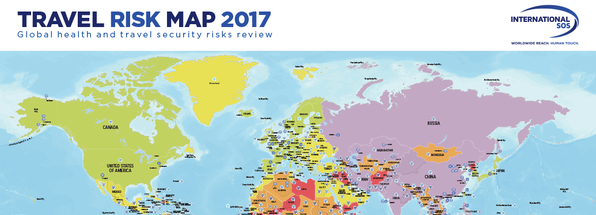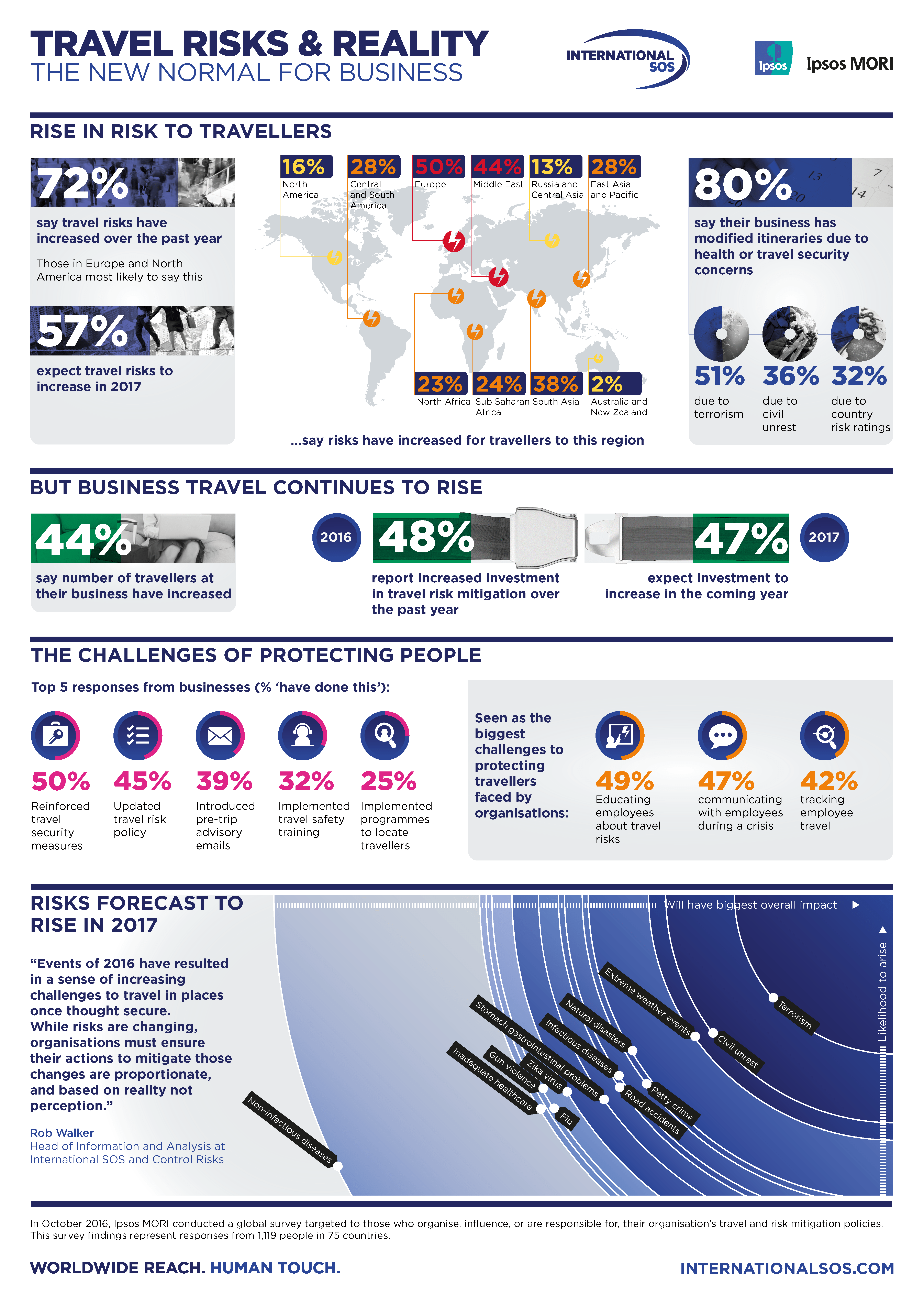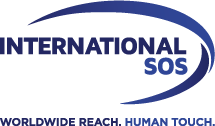Travel Risk Map 2017
London
ORGANISATIONS TAKE CONTROL AS TRAVEL RISKS ARE PERCEIVED TO RISE
INDUSTRY LEADING ‘TRAVEL RISK MAP 2017’ REVEALS LATEST TRAVEL AND MEDICAL RISK RATINGS WORLDWIDE, FROM INTERNATIONAL SOS AND CONTROL RISKS
Ipsos MORI Study Reveals Latest Business Decision-Makers Views on Travel Risks
- 72% believe travel risks have increased over the past year ; 57% anticipate further rise in risk levels
- 1/3 of organisations modified travel itineraries due to country risk ratings
- Nearly half (48%) report an increase in investment to mitigate risks

International SOS and Control Risks, two of the world’s leading medical and security specialists, today launched the industry leading Travel Risk Map for 2017. Providing a comprehensive overview of risks by destination, the Travel Risk Map helps organisations and their mobile workforce in their travel risk mitigation efforts. Last year this resulted in almost ⅓ (32%) of decision-makers changing corporate travel plans.
Rob Walker, Security specialist at International SOS and Control Risks commented: “It is essential for decision-makers to have a reliable source of objective information to help them implement travel risk policies and individual travel plans. The extent of the preparation and support employees need could be determined either by medical or security risks, or by a combination of both. Companies need to take a comprehensive view when preparing their employees for travel and assignments abroad.”
“Events of 2016 have resulted in a sense of increasing challenges in travel to places once thought secure. While risks are changing, organisations must ensure their actions to mitigate those changes are proportionate, and based on reality and not perception. Issues like healthcare provision and road safety, which account for over 70% of the assistance services we have provided in the past year, can often be obscured by more prominent, but less likely issues. With many organisations increasing their business travel activity, it is essential for decision-makers to be able to communicate that objective advice to their people, including in an actual crisis.”
“Keeping informed and taking into account all risk factors will enable business travel to proceed successfully, resulting in a protected workforce and business continuity.”
The Travel Risk Map 2017 is launched alongside a comprehensive Ipsos MORI survey of over 1,000 business decision-makers, responsible for their organisation’s travel risk mitigation in 75 countries, representing in excess of 500,000 travellers globally.
Organisations Challenged to Take Control
Despite an increased perception of risk (72% of respondents), 44% reported a rise in business travel activity in the past year and over half expect further increase in 2017.
- 80% of organisations modified travel itineraries in the past year due to health and security concerns.
- Almost half of respondents (48%) say their organisations investment in travel risk mitigation has increased over the past year, and 47% believe this will increase further in the coming year. The top risk mitigation activities were:
| Reinforced travel security measures | 50% |
| Updated travel risk policy | 45% |
| Introduced pre-trip advisory emails |
39% |
| Implemented travel safety training |
32% |
| Implemented programmes to locate travellers |
25% |
| Provided pre-travel health programmes |
22% |
| Invested in crisis communication systems |
20% |
| Enforced use of mobile check in |
15% |
- Business decision-makers report the greatest challenges in mitigating travel risks are:
| Educating employees about travel risks | 49% |
| Communicating during a crisis |
47% |
| Tracking employee travel |
42% |
| Confirming that employees have read pre-travel information |
37% |
| Travel risk policy compliance |
31% |
| Managing a crisis |
31% |
| Business continuity planning |
23% |
| Implementing a travel risk policy |
23% |
| Confirming that employees have taken travel risk training |
23% |
| Understanding legal obligations to travellers |
22% |
| Management buy-in of travel risk policy |
18% |
Security Risks Higher on the Corporate Agenda than Healthcare
Dominating concerns on a global level are potential terror attacks (71%), followed by the Zika virus (49%) and civil unrest (46%), with inadequate healthcare and road accidents both at 15%. However, these lesser considered, but more common, issues should also be taken seriously.
Dr Irene Lai, Medical Director of Information and Analysis for International SOS, said: “It is vital for companies to familiarise themselves and their travellers with the health risks associated with travel and take measures to reduce those risks. While the Zika virus has had extensive media coverage this year, common medical issues which don’t make the headlines, such as traveller’s gastric issues or running out of regular medication, are more likely and can destroy a business trip.”
“Road accidents are also a major issue and one of the top five causes of medical evacuation. A number of countries showed significant improvement in deaths from road accidents in the past year, but organisations should be mindful that they remain a common major risk.”
Respondents take the following actions to mitigate risk when they travel:
| Share itinerary with family and friends |
59% |
| Research threats at destination |
54% |
| Research vaccination requirements |
42% |
| Research attitudes, cultures and practise of local population |
42% |
| Protect against mosquito bites |
36% |
Rob Walker concludes, “Travellers are much less likely to encounter unexpected or avoidable problems if they plan ahead. Using objective advice to prepare travellers, and by staying up to date on any changes and how they might affect plans, will further reduce, both the likelihood of people experiencing problems, and the extent of the impact.“
International SOS and Control Risks will host webinars based on the key global issues and emerging trends in December 2016. The webinars are open to the public and you can register here.
Learn more about Travel Risk Map 2017 and view the map online at https://www.internationalsos.com/travelriskmap. An interactive digital version is also available. Features include drill-down capabilities to see specific zones within countries that have a higher travel security risk rating, and city/country search functionality. The interactive map is freely available to clients and media to embed in their websites to share the information and educate travellers.
####
About International SOS and Control Risks
Our alliance brings together two of the world’s leading medical and security specialists, International SOS and Control Risks. Our combined resources and expertise are well placed to meet the customers’ growing need for integrated travel security risk services. Our solutions ensure that mobile employees are safe and productive and help employers with their duty of care obligations. 50 dedicated experts, located across the globe with access to over 200 dedicated travel security experts through 26 regional Assistance Centres and a partner network of over 700 accredited providers, produce global travel security information and analysis 24/7. We also provide travel security training, preventative travel assessment, support with the development of travel security risk policies, evacuation plans and the latest technology to enable clients to track and communicate with their mobile employees.
Notes to Editors
1. The Travel Risk Map, the industry’s first integrated medical and travel security risk map, was launched in 2016. Prior to this, International SOS has published a Health Risk Map since 2010.
2. International Travel: Risks and Reality: The New Normal for Business is an Ipsos MORI research study conducted among 1,119 business decision-makers across 75 countries. Research was conducted online using representative panels in the period October 6th to October 26th 2016.
3. Travel security risk ratings are developed by International SOS and Control Risks and are based on the current threat posed to travellers and international assignees by political violence (including terrorism, insurgency, politically motivated unrest and war), social unrest (including sectarian, communal and ethnic violence) as well as violent and petty crime. Other factors, such as the robustness of the transport infrastructure, the state of industrial relations, the effectiveness of the security and emergency services and the country’s susceptibility to natural disasters are also considered where they are of sufficient magnitude to impact the overall risk environment for travellers. Definitions of travel security risk ratings are available at www.internationalsos.com/travelriskmap
4. Medical Risk Ratings are determined by the International SOS Medical Information and Analysis team by assessing a range of health risks and mitigating factors including: infectious diseases, environmental factors, medical evacuation data, the standard of available local emergency medical and dental care, access to quality pharmaceutical supplies, and cultural, language or administrative barriers. Individual country medical risk ratings are determined via a proprietary algorithm based on 24 indicators with content coming from public data sources and the first-hand knowledge of International SOS Regional Medical Directors. Definitions or medical risk ratings are available at www.internationalsos.com/travelriskmap.









